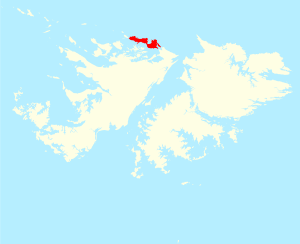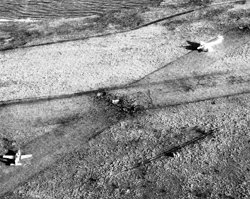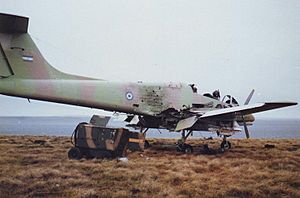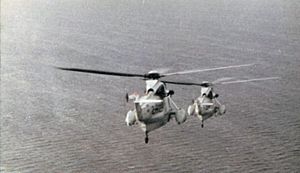Raid on Pebble Island facts for kids
Quick facts for kids Pebble Island Raid |
|||||||
|---|---|---|---|---|---|---|---|
| Part of the Falklands War | |||||||
 Location of Pebble Island (in red), north of the West Falkland island. |
|||||||
|
|||||||
| Belligerents | |||||||
| Commanders and leaders | |||||||
| Maj. Cedric Delves Cap. Gavin Hamilton |
Lt. Ricardo Marega † | ||||||
| Strength | |||||||
| 45 SAS troopers 1 naval gunfire observer 1 destroyer (HMS Glamorgan) 2 helicopters |
150 troops | ||||||
| Casualties and losses | |||||||
| 1 Wounded | 1 Killed 11 aircraft destroyed |
||||||
The Raid on Pebble Island was a secret mission by British Special Forces during the Falklands War. It happened on the night of May 14–15, 1982. Pebble Island is a small island in the Falkland Islands, located north of West Falkland.
Argentine forces were using an airfield on Pebble Island. They had T-34 Mentor and Pucara planes there. These planes could watch British ships. British Special Air Service (SAS) soldiers were given the job to destroy these aircraft. This mission was similar to some of the SAS's first missions in World War II.
SAS soldiers from HMS Hermes were chosen for the raid. They had help from two Royal Navy ships. HMS Broadsword protected Hermes. HMS Glamorgan provided powerful naval gunfire support.
On the night of May 14, two Sea King helicopters took 45 SAS soldiers to the island. The team got to the airfield without being seen. They placed explosives on seven aircraft. After setting the charges, they fired at the planes with small guns and rockets. All the aircraft were damaged. Some even had their landing gear shot off.
Then, Glamorgan started firing shells at the Argentine positions. They hit the ammunition and fuel storage areas. The Argentine defenders did not fight back until the SAS team was leaving. One British soldier was hurt by an Argentine explosive device. The SAS fired back, and the Argentine commander was killed. The wounded soldier was taken back to the helicopters. The team left before sunrise.
Contents
Why the Raid Happened
After Argentina took over the Falkland Islands, they built a small airbase. This base was on Pebble Island, which Argentina called Isla Borbón. They used the local airstrip for their planes. These planes included FMA IA 58 Pucará and T-34 Mentor aircraft. These planes were used for reconnaissance and light attacks. They could spot the Royal Navy's movements. This could have put the British landing plans at risk.
The SAS soldiers on HMS Hermes were tasked with stopping this threat. They had naval support for the mission. HMS Broadsword helped protect Hermes. The destroyer HMS Glamorgan gave naval gunfire support. This meant it used its large guns to fire at targets on land. A special officer, Captain Chris Brown, helped guide the ship's gunfire.
Planning the Mission
The first idea was for a large group of SAS soldiers to fly in from Hermes. They would destroy the planes, radar, and ground crew. They would also deal with the soldiers protecting the base. Then, helicopters would pick them up before morning.
Scouting the Area
SAS soldiers from the Boat Troop did a secret scouting mission. They used small canoes to get to the island. They found that strong winds would make the helicopter flight longer. This meant less time for the mission on the ground. Instead of 90 minutes, they would only have 30 minutes. Because of this, destroying the aircraft became the main goal. Dealing with support staff became a secondary goal.
The Raid Begins
On the night of May 14, two Sea King helicopters took off. They carried 45 SAS soldiers. They landed about 6 kilometers (3.7 miles) from the airstrip. One group of soldiers focused on destroying the Argentine aircraft. The other soldiers protected the area. They also formed a backup force.
The raiding party carried many mortar bombs and explosives. They also had anti-tank rockets. Each soldier carried at least two mortar bombs. For their personal weapons, they used M16 rifles. Some of these rifles had M203 grenade launchers attached. A soldier who had scouted the area guided the team.
What Happened During the Fight

As the SAS team got close, they saw an Argentine guard. But the guard did not see them. This allowed the SAS to place explosives on seven aircraft. Once the explosives were ready, the team opened fire. They used small guns and rockets. All the planes were damaged. Some even had their landing gear shot away. After this, Glamorgan started shelling the Argentine positions. It hit the ammunition and fuel storage areas.
The Argentine defenders did not fight back right away. They waited until the entire SAS team had gathered. One British soldier was hurt by an Argentine explosive device. The SAS team fired back with small arms and grenade launchers. This led to the death of the Argentine commanding officer. It also stopped any further resistance.
The Argentine side said their marines stayed in shelters during the shelling. This meant they could not fight the SAS. They also said the British soldier's injury was from shrapnel. This shrapnel came from explosives the Argentines had planted. They put these under the airstrip to stop the British from using it. They set off these explosives because they thought it was a full attack to take over the base.
Leaving the Island
The wounded soldier was carried back to the pickup spot. The raiding party reached the helicopters on time. They were transported back to Hermes before daybreak. The team decided to leave instead of going back to fight the remaining Argentine forces.
After the Raid
The raid destroyed several important things:
- Six FMA IA 58 Pucará planes (from the Argentine Air Force)
- Four Turbo Mentor trainer/light attack aircraft (from the Argentine Naval Aviation)
- One Short SC.7 Skyvan transport plane (from the Coast Guard)
- The ammunition storage area
- The fuel storage area
The raid was a complete success. It reminded people of the types of missions the SAS did in the Second World War. One of the officers involved, Captain Hamilton, was later killed. This happened in another SAS mission near Port Howard. The Argentine forces stayed on Pebble Island for a while. They were later taken off the island on June 1, 1982. Two Argentine Navy Sea King helicopters rescued the last troops.
See also



